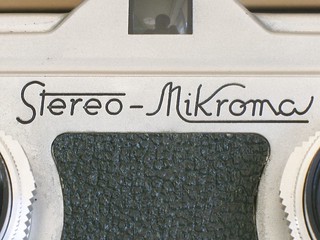Stereo-Mikroma
The Stereo-Mikroma is, as the name suggests, a stereo camera based on the Mikroma, made by Meopta in Prerov (then in Czechoslovakia; now the Czech Republic) from 1961. It is usually covered with green leatherette. It uses 16 mm film (either 'silent' film, with perforations on each edge, or 'sound' film with only one set of perforations, in which case a slightly larger image is obtained).
The camera has two Mirar 25 mm f/3.5 lenses (slightly longer than the 20 mm Mirar on the Mikroma). It has a simple shutter, in which the speed is controlled by variable spring tension. Thus, although there are marked speeds 1/5 - 1/100 second, plus 'B', the speed is continuously variable; intermediate positions on the dial give intermediate speeds. The shutter is synchronised for flash, with a PC socket on the top plate. The shutter is cocked with the sliding control on the back of the top housing. On the Mikroma, this control also advances the film, but the stereo camera has a separate winding knob.
The lenses do not focus; instead, there are pairs of auxiliary focusing lenses (one for the 1-3 meter range, and another for 0.6-1 metre).
The camera has a reverse-Galilean viewfinder.
The Stereo-Mikroma II is an updated model.[1] This does not have the control to cock the shutter; this is now automatic with the film advance. There are also some style changes to the body, and it usually has black leatherette.

|
| Stereo-Mikroma image by makopunpun (Image rights) |

|
| Meopta Stereo-Mikroma II image by cgancedo65 (Image rights) |

|
| image by makopunpun (Image rights) |

|
| image by makopunpun (Image rights) |

|
| Stereo-Mikroma with close-up lenses image by Richard Bugg (Image rights) |
Notes
- ↑ Stereo-Mikroma (green) and Stereo-Mikroma II (black) with a cutter for mounting the stereo pairs, sold at the twelfth Westlicht Photographica Auction, on 17 November 2007.
Links
- Stereo-Mikroma and Stereo-Mikroma II user manuals (in Czech) at Meopta Reels
- More views of the Stereo-Mikroma, from makopunpun on Flickr.
- Stereo-Mikroma with auxiliary lens pairs for 1-3 m and 0.6-1 m focus ranges, sold at the sixteenth Westlicht auction, on 5 December 2009.
- Stereo-Mikroma review at Vintage Camera Quest